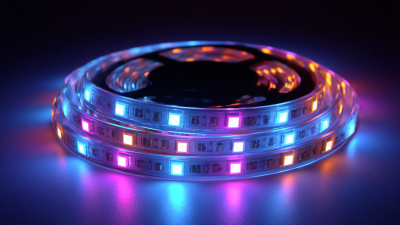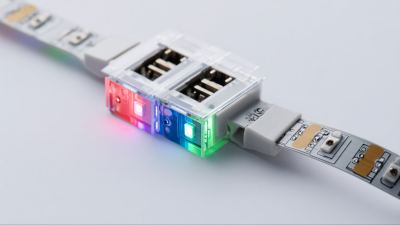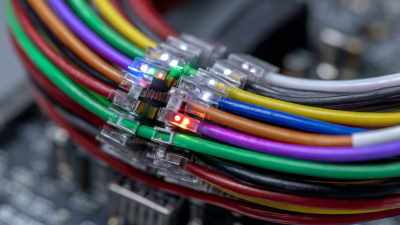Exploring Unique Alternatives to Traditional Light Strips for Your Home Decor
 In recent years, the home decor industry has seen a significant surge in the popularity of innovative lighting solutions,
with light strips taking center stage. According to a report by Grand View Research,
the global LED lighting market is expected to reach $143.64 billion by 2026, driven in part by the growing
appeal of versatile lighting options like light strips. These flexible, adhesive-backed lights can transform any space,
providing both functional and aesthetic benefits. However, as homeowners seek unique alternatives
to traditional lighting methods, creative options beyond standard light strips are emerging. This blog explores various
innovative alternatives that can elevate your home decor, offering a fresh take on how we illuminate our living spaces.
Whether you desire the ambiance of a cozy nook or the vibrancy of color-changing features,
there are countless ways to brighten up your home while standing out from the conventional use of light strips.
In recent years, the home decor industry has seen a significant surge in the popularity of innovative lighting solutions,
with light strips taking center stage. According to a report by Grand View Research,
the global LED lighting market is expected to reach $143.64 billion by 2026, driven in part by the growing
appeal of versatile lighting options like light strips. These flexible, adhesive-backed lights can transform any space,
providing both functional and aesthetic benefits. However, as homeowners seek unique alternatives
to traditional lighting methods, creative options beyond standard light strips are emerging. This blog explores various
innovative alternatives that can elevate your home decor, offering a fresh take on how we illuminate our living spaces.
Whether you desire the ambiance of a cozy nook or the vibrancy of color-changing features,
there are countless ways to brighten up your home while standing out from the conventional use of light strips.
Alternatives to Traditional Light Strips: Innovative Ideas for Home Aesthetics
When it comes to enhancing home aesthetics, traditional light strips are popular due to their flexibility and ease of installation. However, innovative alternatives are emerging that offer unique styles and functionalities. For instance, according to a recent report by Allied Market Research, the global smart lighting market is projected to reach $130.4 billion by 2027, indicating a growing interest in advanced lighting solutions beyond conventional offerings. Smart LED panel lights, for example, can create customizable scenes and moods while integrating seamlessly with home automation systems.
Another exciting alternative is the use of LED neon flex, which mimics the nostalgic look of neon while being energy-efficient and versatile. The industry is seeing a trend toward these vibrant light designs as consumers seek to create personalized spaces. A survey by the American Lighting Association found that over 60% of homeowners prioritize aesthetics and ambiance in their lighting choices, which opens the door for unique fixtures like artistic pendant lights or illuminated wall art. These innovations not only enhance visual appeal but also provide functionality and sustainability, making them ideal for modern home decor.
Exploring Unique Alternatives to Traditional Light Strips for Your Home Decor
This chart illustrates the popularity of various alternatives to traditional light strips for home decor, measured by the percentage of home decor enthusiasts who prefer each option.
How to Select the Right Type of Lighting for Different Spaces in Your Home
When selecting the right type of lighting for different spaces in your home, it's essential to consider both functionality and aesthetics. Recent trends highlight the shift towards intelligent home solutions, with market opportunities projected to grow significantly in the next decade. For instance, a report indicates that the multifunctional furniture market is expected to expand from $64.1 billion in 2022 to $85.5 billion by 2030, reflecting a strong shift towards practical design that enhances living spaces.
One popular alternative to traditional light strips is track lighting, which offers versatility and design appeal. It allows homeowners to spotlight specific areas and can be customized to fit various decor styles. As highlighted in a recent guide, evaluating the installation complexities and functionality can help beginners make informed choices, ensuring a perfect match for their space.
Tip: When choosing lighting, consider the mood you want to create in each room. Warm lights work best for cozy environments like bedrooms, while cooler lights can enhance productivity in home offices. Additionally, integrating smart lighting options can not only add a tech-savvy element to your decor but also provide convenience through adjustable settings tailored to different times of day.
Creative Uses of Wall Art as an Alternative Lighting Source
Wall art has long been celebrated for its ability to enhance the aesthetic of a room, but it can also serve a functional purpose as an alternative lighting source. Creative uses of wall art can transform your living space, allowing you to innovate how you illuminate your home.
For instance, consider using backlit canvas art. By placing LED light strips behind a canvas or a framed piece, you not only highlight the artwork but also create a soft, ambient glow that sets a cozy atmosphere. This method can work wonders in bedrooms or living rooms where a relaxed vibe is essential.

Another unique approach is incorporating artistic light fixtures directly into your wall art. Sculptural pieces that double as lighting can be both dramatic and functional. For example, a three-dimensional metal or wood wall sculpture can include built-in LED lights that not only enhance the artwork but also provide necessary illumination.
This fusion of art and technology can draw attention and serve as a conversation starter, making your space not just visually appealing but also uniquely personalized. By rethinking the role of art in your decor, you can achieve a layered, dynamic look that modernizes your home while being anything but ordinary.
Understanding the Benefits of Smart Lighting Solutions Beyond Strip Lights
When considering home decor, smart lighting solutions extend beyond conventional light strips, offering an innovative approach that enhances both functionality and aesthetics. One of the most significant benefits is the ability to customize lighting settings to suit various moods and activities. With smart bulbs and fixtures, homeowners can easily adjust brightness levels and color temperatures through a smartphone app or voice commands. This flexibility allows for a dynamic atmosphere, whether you’re entertaining guests, enjoying a cozy evening, or focusing on work.
Furthermore, smart lighting solutions contribute to energy efficiency and convenience. Many smart lighting systems come with sensors and schedules, enabling lights to turn off automatically when nobody is home or dimming at specific times of day. This not only reduces energy consumption but also simplifies daily routines. Additionally, integrating smart lights with home automation systems means that your lighting can work in harmony with other smart devices, enhancing security and providing an overall seamless living experience. By exploring these alternatives, homeowners can create a more personalized and sustainable environment that traditional light strips alone cannot offer.
Incorporating Natural Light Features to Enhance Your Home Decor
Incorporating natural light features into your home decor can be a transformative experience. Unlike traditional light strips that often create a stark, artificial ambiance, natural light elements infuse your space with warmth and vitality. Consider the strategic placement of mirrors that reflect sunlight, enhancing brightness and making your room feel more expansive. Additionally, skylights or large windows can dramatically alter the atmosphere of a space, allowing the beauty of the outdoors to become part of your interior design.

Another innovative way to bring natural light into your home is through the use of translucent materials. Light-filtering curtains or frosted glass partitions can diffuse sunlight while maintaining privacy, creating a serene environment. Plants are also essential in this approach—window sills adorned with greenery can soften harsh light and improve air quality, creating a refreshing, organic feel. By embracing these natural light features, you can cultivate a unique decor that harmonizes with your surroundings and enhances your overall living experience.
Related Posts
-

The Ultimate Guide to Choosing the Perfect LED Strip for Your Project
-

How to Choose the Best LED Strip Connector for Your Lighting Projects
-

How to Choose the Best LED Light Harness for Optimal Performance and Efficiency
-

Unlocking the Technical Specifications of the Best LED Light Wiring Harness for Global Buyers
-

Exploring Unique Alternatives to Traditional LED Wiring Harness Solutions
